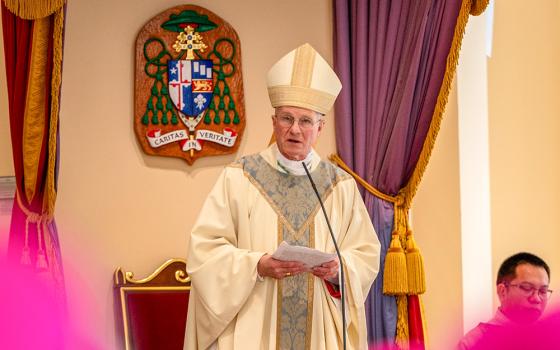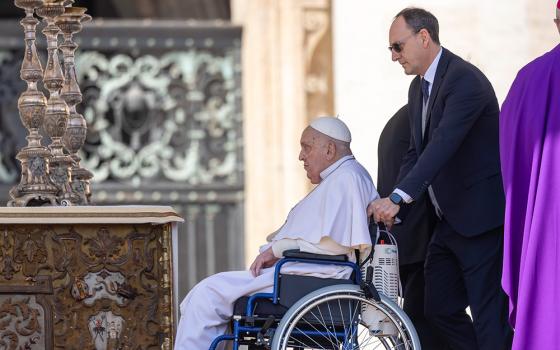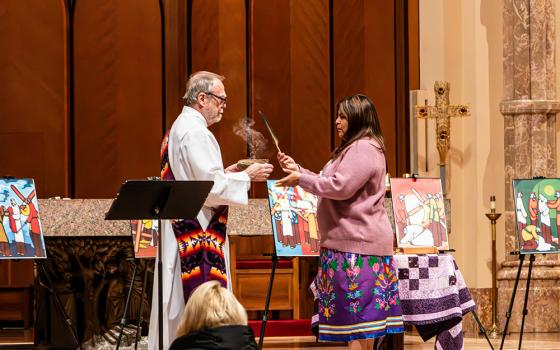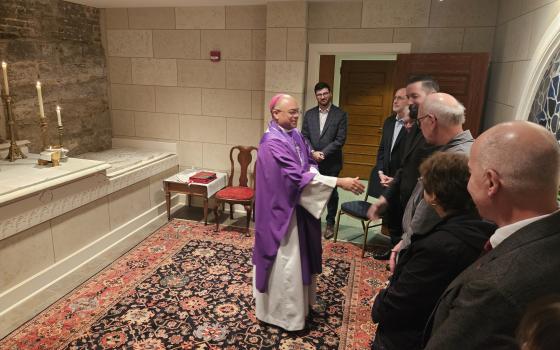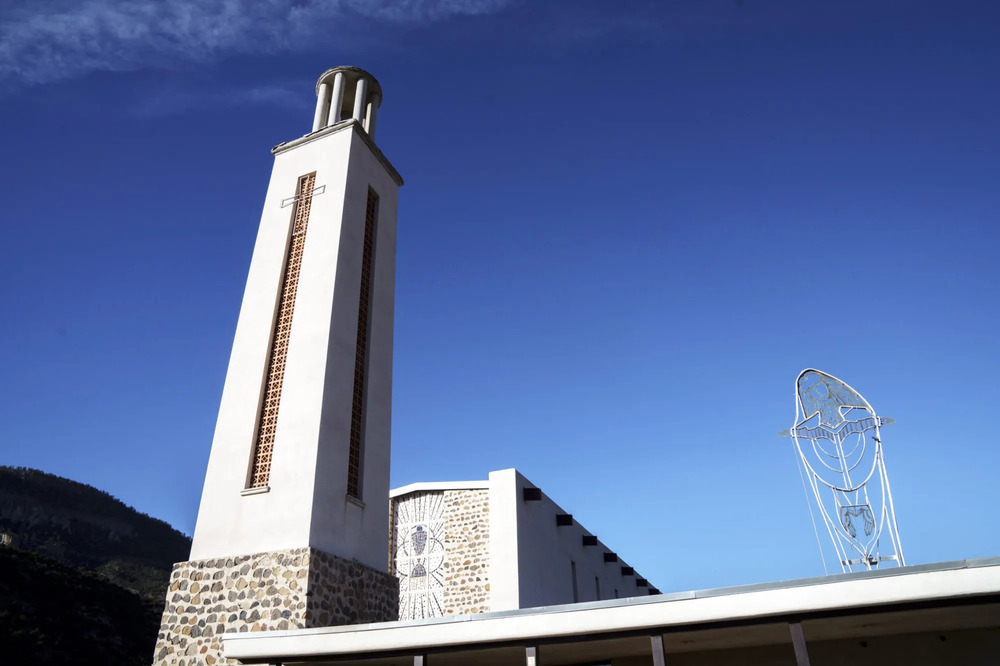
The Servants of the Paraclete center in Jemez Springs, former site of a controversial treatment facility for priests who had sexually abused minors and dealt with substance use. (Nadav Soroker/Searchlight New Mexico)
When the Archdiocese of Santa Fe filed for bankruptcy on Dec. 3, 2018, church officials said they were dangerously close to burning through their financial reserves after settling lawsuits with nearly 300 survivors of sexual abuse that occurred in this huge religious district, which encompasses 19 counties in central and northeastern New Mexico and the cities of Albuquerque, Santa Fe, Los Alamos and Taos.
As part of the proceedings at the federal bankruptcy court in Albuquerque, any "creditor" — the legal term used for abuse survivors — who had a financial claim against the church was given a chance to come forward and make their debt known.
Court records show that dozens of people, identified only as John and Jane Does, filed claims initially valued at $100,000 each. Between 1957 and 2018, the Does alleged, they had suffered sexual abuse at the hands of clergymen working for the Albuquerque-based archdiocese, most of whom were added to the church's publicly accessible "List of Priests, Deacons, Religious, and Seminarians Credibly Accused of Sexual Abuse of Minors." Many others were not added to the list, though, and the archdiocese has shown no interest in changing that.
'When the church is settling claims in the mid-six figures or higher, they’re acknowledging, tacitly, the validity of these allegations,' said Levi Monagle, an attorney who represented sex abuse survivors during the archdiocese’s bankruptcy case.
Five years after proceedings began, the archdiocese reached a deal. With a $121.5 million payout, the church resolved the claims of some 400 John and Jane Does. The settlement also effectively blocked any additional claims about abuse that happened prior to the settlement from being litigated in the future.
In addition to the $121.5 million, the settlement established a new document archive whose contents will range from victim and witness depositions to police reports and archdiocese personnel files on individual priests. This archive, called The Archdiocese of Santa Fe Institutional Abuse Collection, will be housed at the University of New Mexico's special collections library and will offer details on decades' worth of sex abuse allegations that took place in this state. The settlement also mandated the creation of a fund that potential future victims can submit claims against.
Amid the church's public efforts to make things right, preserve the past and move on to the future, there remains a painful point of contention. Like archdioceses across the nation, Santa Fe has control over its list of credibly accused priests, and bankruptcy didn't change that. The list currently names 83 priests — a separate list containing the names of clergy who worked in the archdiocese but were accused of wrongdoing elsewhere contains 22 names, for a total of 105 — and critics say the sum is an undercount. According to Levi Monagle, an Albuquerque-based attorney whose firm represented about 140 people who alleged sexual abuse during the church's financial reorganization, if everyone accused during the bankruptcy were added to the main list, it would grow by up to 59 names, an increase of 71 percent.
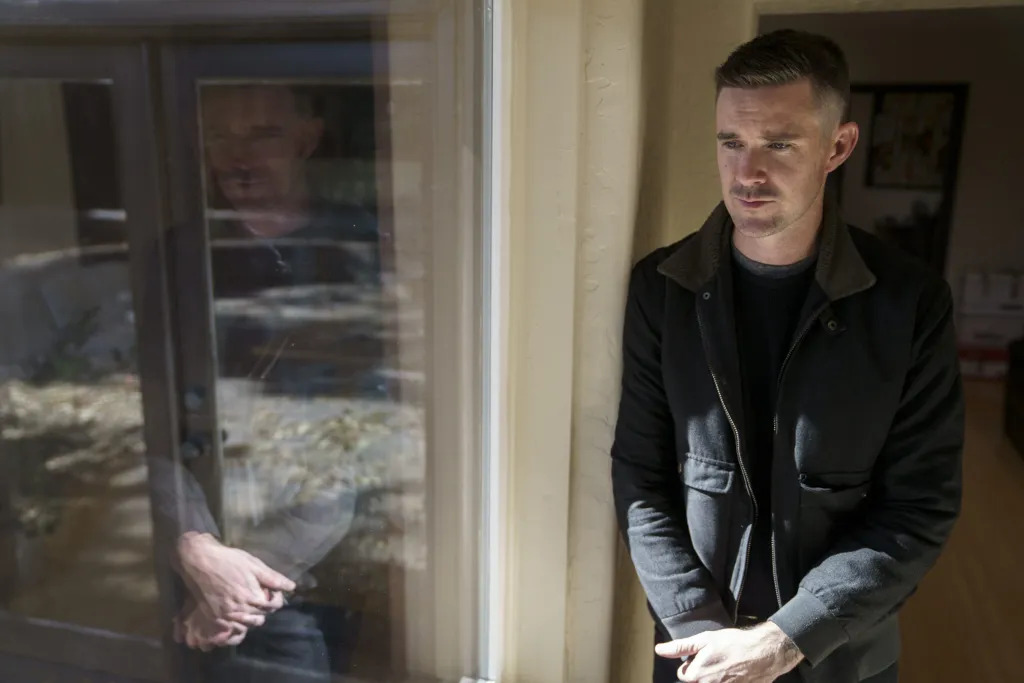
Albuquerque attorney Levi Monagle. (Nadav Soroker/Searchlight New Mexico)
Notably, all 59 of these priests were the subject of financial settlement agreements, and Monagle argues that this represents an admission by the archdiocese that they were, indeed, "credibly accused." Although the priests' cases were settled in court, their identities are currently sealed and kept from public view, and it remains to be seen whether any of them will appear by name in the forthcoming UNM archive. It's possible that documents submitted to the archive by survivors will include at least some of the 59 names.
The fact that the names are sealed doesn't mean the church cannot — or should not — put them on its list, Monagle said. "Just because these … are sealed to the public does not mean that they are sealed to the archdiocese," he said. "The archdiocese has complete control over the names it includes or does not include on its list."
Monagle, who has seen the names, contends that the church ought to take the step of publicly listing them, since it was willing to settle the underlying allegations. "When the church is settling claims in the mid-six figures or higher, they're acknowledging, tacitly, the validity of these allegations," he said. He attributes the church's resistance to adding more clergymen to "a matter of scale" — meaning it could signal that the church's abuse problem went much deeper than what has been previously acknowledged.
"This is also a question of the credibility of the original list itself," Monagle said. "In some ways, if it was a negotiated term of bankruptcy that the archdiocese is forced to nearly double the size of its credibly accused list, that would raise some eyebrows about how forthright they've been."
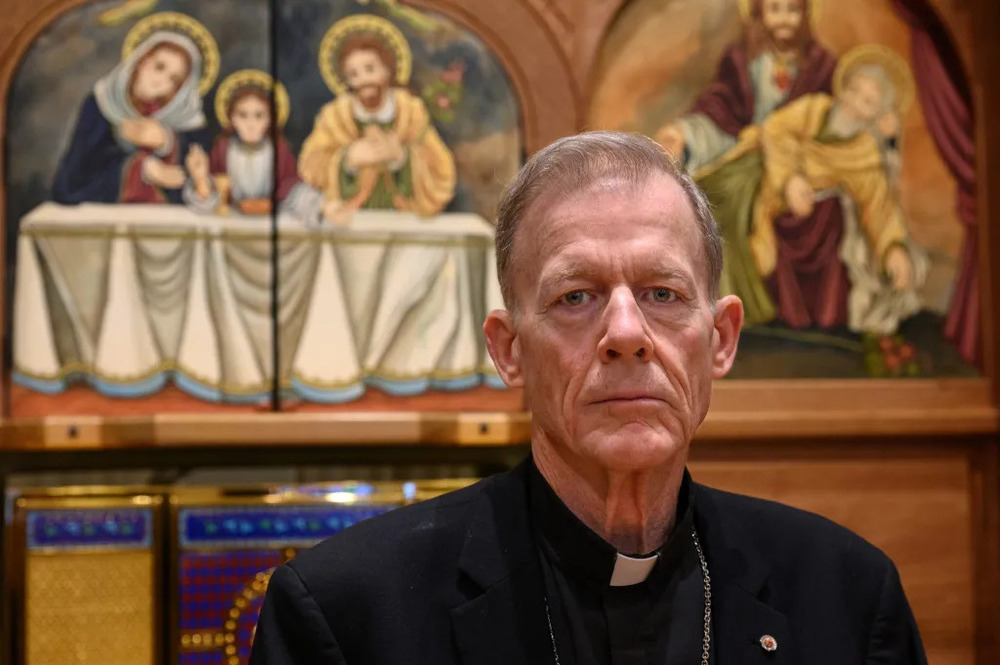
Archbishop John Wester at the Cathedral Basilica of St. Francis of Assisi in Santa Fe. (Michael Benanav/Searchlight New Mexico)
'The clear hallmarks of an abuser'
Last year, Monagle took the diocese to court over the matter, contending that the church was violating bankruptcy terms by refusing to add these priests. Central to his argument was the late Fr. Richard Spellman, a priest who in the 1950s started working at Our Lady of the Most Holy Rosary, near Petroglyph National Monument on Albuquerque's west side.
One of Monagle's clients, 76-year-old Mela LaJeunesse, said that Spellman sexually abused her as a child for years, starting in 1957. In 2016, she sought treatment for the abuse, according to court records, and in 2019 she filed a "proof of claim" — a document that outlined Spellman's abuses and made her eligible to receive a financial settlement — as part of the church's bankruptcy. Court records show that Monagle repeatedly emailed the archdiocese's attorneys to clarify whether Spellman's name would be included in its credibly accused list.
"Fr. Spellman's personnel file bears the clear hallmarks of an abuser," Monagle wrote to the archdiocese's attorneys in December 2022. They responded that his name would be "considered for inclusion." Court records show that months passed before an attorney wrote to Monagle to say that the Independent Review Board, a body primarily composed of non-clergy that meets regularly to investigate sex abuse allegations and brief the archbishop on its findings, had met and "recommended that Fr. Spellman not be put on the credibly accused list. The archbishop accepted their recommendation."
Little is known publicly about the Independent Review Board and its members, whose identities are shielded. They are usually non-clergy professionals, including police officers, judges and psychiatrists. Likewise, little is known about how the members make decisions — for example, when the board made its recommendation about Spellman, Monagle learned of it not through any sort of public announcement but because he emailed one of the church's attorneys. The archdiocese's website says the board is a "confidential consultative body to the archbishop, advising him by independent assessment of allegations of sexual abuse of minors and determination of continued suitability for ministry."
Monagle, who has represented survivors of Catholic sex abuse for 11 years, accused the church of violating the settlement agreement, which states that it will regularly update its list of priests. In court, the church argued that accusers should not get final say on whether a priest is listed, because the decision ultimately rests with the archbishop. Judge David Thuma, who presided over the case — and is a former law partner with the archdiocese's counsel during bankruptcy, Walker and Associates — agreed in a June 2024 opinion.
Critics contend that Thuma should have recused himself, but even if he had, the only other bankruptcy judge in New Mexico, Chief Judge Robert H. Jacobvitz, is also a former law partner with the same firm. Neither Thuma nor Jacobvitz would comment for this story.
Who determines what's credible?
In a November interview with Searchlight New Mexico about the aftermath of the church's reorganization, Santa Fe Archbishop John Wester initially contended that the archdiocese's list did, in fact, contain the names of every priest whose sex abuse allegations were settled during bankruptcy. "We wouldn't have a priest who we paid money out for in the bankruptcy and not put him on the credibly accused list," he said. "There aren't some priests that are in the files but not on the list."
When Searchlight pointed out that this was false, and that priests like Spellman were absent from the list, Wester said: "That would be news to me." He then asked if the Searchlight reporter could be put on hold.
'Selective transparency is its own form of evasion,' Monagle said. 'The church wants them to have this gloss of completeness. That simultaneously preserves the church's ability to decide which victims are credible and which are not.'
After returning nearly seven minutes later, Wester acknowledged that many of the priests whose cases were settled during bankruptcy have not been included on the list. Why? Primarily, he said, because the Independent Review Board has not investigated their cases. When asked if the board should, Wester said he wasn't sure. He also said that, in some instances, church lawyers decided to pay alleged victims without being certain that they'd been abused.
"There were a lot of cases in bankruptcy where they just presented them and we said, 'OK, we're going to pay you the money,' and the IRB did not take a look at that, so they can't recommend it be put on the credibly accused list," he said.
Asked again if the Independent Review Board ought to review the status of the list, Wester said he was not prepared to answer the question. In an email sent on Feb. 7, Wester said he has made a decision: he will not direct the board to review the abuse allegations settled during bankruptcy.
"That process was independent from the policies we follow when a victim survivor comes to us with an allegation," Wester wrote. "We only investigate cases that come to us from a victim survivor. Then, if we deem the allegation as credible, we put the perpetrator's name on our credibly accused list."
Although the 59 names are sealed, Wester never offered that as a reason why they should not be added to the archdiocese's credibly accused list. The decision not to investigate those cases, he said, happened because the bankruptcy settlements were handled "independent" of the church's usual policies.
The archbishop has earned a reputation as a thoughtful, progressive leader for the Archdiocese of Santa Fe since he stepped into the role 10 years ago. He's been a vocal advocate for nuclear disarmament and has urged Americans to take a humane approach to hot-button issues like immigration, because "our Christian faith urges us to care for the resident and the stranger." In 2021, when the archdiocese announced its plans to sell off more than 700 of its properties during bankruptcy, Wester said the church sold everything it could — "including my residency."
Wester, who cooperated with opposing lawyers in the creation of the abuse archive and is a signatory on the Memorandum of Agreement that set it up, discussed what he sees as the positive aspects of the bankruptcy settlement. Any archdiocese has the option to deal with claims on a case by case basis, which some do. To Wester, though, bankruptcy was a chance to rebuild the church with what he calls "living stones," by which he means "not just the brick and mortar or money, but the people of God." Declaring bankruptcy made sense, he said, because it allowed the church to give restitution to a large pool of sex abuse survivors, rather than continue to settle claims individually and run the risk of reaching a point where the church could no longer afford such settlements.
"This is a healing process for all of us, the victims and the church," he said. "Let's look at the whole playing field, and let's see that we can give everybody something, rather than the first in line gets something and the last get nothing."
Advertisement
For all the healing and progress the archdiocese has achieved, though, the issues of the list and its many omissions remain. Other dioceses across the nation have kept accused priests off their lists, too. In 2011, the Archdiocese of Boston released a credibly accused list and stated that it intentionally left the names of 91 priests off for a number of reasons, including unsubstantiated accusations that weren't made publicly. Similarly, The Guardian in 2023 reported that the Archdiocese of New Orleans — which has recently made headlines for relying on the crisis communications expertise of the NFL's New Orleans Saints public relations team — maintained a credibly accused list containing 77 names, and neglected to include the names of at least 56 other priests and deacons.
"Selective transparency is its own form of evasion," Monagle said. "The church wants them to have this gloss of completeness. That simultaneously preserves the church's ability to decide which victims are credible and which are not. In a situation where the church has lost its credibility with respect to so many other aspects of the clergy abuse crisis, there's this subtle maneuver by the church to preserve this truth-telling mandate through these lists."
Four phases of the crisis
Public awareness of the Catholic sex abuse crisis exploded in the early 2000s, in the wake of The Boston Globe's reporting on clergy abuse and official church coverups in the Boston area. The Globe's coverage won a Pulitzer Prize and was later depicted in the film "Spotlight."
Spotlight's work had such a profound impact that it's easy to forget how much reporting and investigation preceded it. Elsewhere in the country, this sort of abuse had been thoroughly written about since the 1980s — and as far back as 1993, coverage in The New York Times warned that sex abuse allegations in the Archdiocese of Santa Fe could bankrupt it.
According to Terry McKiernan, co-director of the Massachusetts-based watchdog group Bishop Accountability, revelations about clergy abuse can be sorted into four phases. What he calls the Louisiana phase happened in the mid-1980s, when a priest named Gilbert Gauthe became the first in the nation to receive widespread exposure for the sexual abuse of children — thanks to groundbreaking work by Louisiana journalist Jason Berry. After initially pleading guilty by reason of insanity, Gauthe served 20 years on a plea deal that convicted him of child pornography, contributing to the delinquency of a minor and crimes against nature.
Phase two, in the 1990s, involved significant cases of abuse in New Mexico, Minnesota, Massachusetts, California, and Texas, along with many other places in the U.S. and abroad. The Spotlight phase came next. Now, McKiernan says, we're in phase four, kicked off by a 2018 grand jury report in Pennsylvania that investigated allegations of sex abuse in six of the state's eight dioceses. The nearly 1,400-page report is considered to be the most in-depth government investigation ever conducted into the church's sex abuse crisis.
'The word 'severely' is a relative term,' Sanchez replied, 'and I could not accept that word. I was aware that they were hurt, but how severe that would be was not known to me.'
The Archdiocese of Santa Fe became part of the story in the 1990s. During a flurry of lawsuits against a former Massachusetts priest named James Porter — who was accused of abusing up to 100 children in five states — it was discovered that in the 1960s he had undergone treatment at a rehabilitation facility for troubled priests in Jemez Springs, New Mexico, a scenic mountain village about 60 miles northwest of Albuquerque.
During that period, local and national reporters, including Bruce Daniels of The Albuquerque Journal and Mike Wallace of "60 Minutes," revealed that Albuquerque-based Archbishop Robert Sanchez — who is not on the archdiocese's credibly accused list — admitted to violating his vow of celibacy for nearly 20 years by having sexual relationships with several women, including two who were only 18, in the 1970s and '80s. One woman alleged that he compared her to Our Lady of Guadalupe to seduce her, and several said he used his position of power to coerce them into sexual activities. Survivors of sexual abuse also accused Sanchez of turning a blind eye to the molestation committed by priests under his supervision. Reports at the time indicated that at least 100 children had been abused by 20 priests in the Archdiocese of Santa Fe.
Sanchez resigned in 1993; victims of sexual abuse filed lawsuits against him and the archdiocese. In a 1994 deposition that local news outlets sued to unseal, he appeared not to understand that he and other priests had done anything wrong. Speaking to the late Albuquerque attorney Bruce Pasternack, he said that instances of sex abuse were kept secret because he "did not understand (molestation) to be a crime" and did not want to invite scandal into the sanctuary.
At one point, Pasternack asked: "Did you … know even in the '70s that a child who was sexually molested by an adult would likely be severely emotionally injured by that event?"
"The word 'severely' is a relative term," Sanchez replied, "and I could not accept that word. I was aware that they were hurt, but how severe that would be was not known to me."

The grave of Fr. Gerald Fitzgerald at the old Via Coelie Monastery. (Nadav Soroker/Searchlight New Mexico)
It wasn't until the second phase, when accused priests across the U.S. were found to have passed through New Mexico for treatment, that the nation began to understand the scope of the problem, McKiernan says. Priests like Porter were sent to a facility run by a religious order known as the Servants of the Paraclete in Jemez Springs.
The facility, called the Via Coeli Monastery, was opened in 1947 as a home for "infirm priests," according to one newspaper report. For decades, and even today, relatively little is known about the monastery's day-to-day operations.
"Via Coeli Monastery is unknown to the majority of America's Roman Catholics," a 1970 article in The San Francisco Examiner said. "Even to those for whom the name is familiar, the purpose of the monastery often remains vague or clouded." A psychologist worked on-site once a week, the article said, and an Alcoholics Anonymous chapter met there weekly.
It's clear from these that Fitzgerald did not anticipate how much of his life's work would be swept up in dealing with sexual abusers.
As the article explained, "Father Gerald Fitzgerald," the facility's founder, "sums up the philosophy of the monastery in three words: 'Priests helping priests.'"
Details about what went on in the monastery and what its treatment included are largely found in archival sources. It's clear from these that Fitzgerald did not anticipate how much of his life's work would be swept up in dealing with sexual abusers.
In his 2013 book "Mortal Sins: Sex, Crime and the Era of Catholic Scandal," journalist Michael D'Antonio documented that Fitzgerald intended to treat priests who struggled with alcoholism, but "reluctantly agreed" in the 1950s to also work with priests who raped children. "Fitzgerald intended to discuss the issue of clergy abuse with Pope Pius XII in 1957," D'Antonio wrote, "and his plan to house offender priests, whom he called 'vipers,' on an isolated island." (Fitzgerald apparently put $5,000 down as a deposit on such an island, but never finalized the sale.)
"Personally I am not sanguine of the return of priests to active duty who have been addicted to abnormal practices, especially sins with the young," Fitzgerald wrote to Pope Paul VI in 1963. "However, the needs of the Church must be taken into consideration and an activation of priests who have seemingly recovered in this field may be considered but is only recommended where careful guidance and supervision is possible. Where there is indication of incorrigibility, because of the tremendous scandal given, I would most earnestly recommend total laicization."
From Jemez Springs to the rest of the nation
Many of the religious order's documents have been lost — some experts believe they were destroyed in the 1990s — but one that emerged in 2007 during settlement proceedings for the Archdiocese of Los Angeles offers a window into the role of the Jemez Springs rehab facility.
The five-page document contains a typewritten recap of a meeting held at the Archbishop of Santa Fe's office. The first page starts with a motto: "The work of the paraclete is the rebuilding of priestly lives." The following pages lay out a plan: Priests who were rehabilitated at Jemez Springs for a number of issues, including alcoholism and substance abuse, should begin working at churches in Albuquerque and Santa Fe as the final step in their rehabilitation. And parishioners need not know why the newly arrived priests had been undergoing treatment.
"In placing men in the parishes, the Archbishop would use his judgment in informing the pastors only of what he thought they must absolutely know about the priest they were receiving, so that they might more effectively work with the man," the document says. "No details or particulars of a clinical nature need to be made known regarding the man's past history.
In this way, Jemez Springs became a recycling mill for abusive priests. They could leave their parishes for treatment in the New Mexico wilderness and emerge elsewhere as new men in new congregations, where few people — if any — knew about their prior offenses.
One typical example was Rudy Kos, a Dallas priest who was sentenced to life in prison in the 1990s for sexually assaulting altar boys. Kos had undergone treatment in Jemez Springs — one of his victims alleged that Kos would call him on the phone from there and return to Texas to abuse him when he was on leave from treatment. Another is Bernard Bissonnette, who was ordained in Connecticut in the 1950s and was sent to Jemez Springs in 1963 after being accused of child sex abuse; he later went on to serve as a chaplain in a New Mexico detention center for at-risk boys and was accused of molesting the inmates. Edward Graff, a Pennsylvania priest, was sent to Jemez Springs in the 1980s for "undefined but 'serious'" issues, according to a Pennsylvania grand jury report. He was arrested in Texas in 2002, after a 15-year-old boy said Graff hired him to work at a church rectory, where Graff showed him pornographic movies and assaulted him.
"People don't appreciate how important the Archdiocese of Santa Fe is," McKiernan said. "The reason it's important is the Servants of the Paraclete. Lots and lots of dioceses were sending their guys there." It's also hard to overstate the significance of what that could mean for credibly accused lists across the nation, he said.
"If you were to include on the Santa Fe credibly accused list all of the priests who were at Servants of the Paraclete and were assigned to parishes for ministry when they thought that they were reliable enough to be farmed out, you've got a list that is hundreds, if not over a thousand," McKiernan said. "Even if they're not accused of abusing kids, kids were at risk in those parishes when those men were working there."
A long, painful history
While much of the discourse surrounding Catholic sex abuse has centered on the East Coast, experts say there was a perfect storm that enabled abuse in New Mexico. Since the days of Spanish colonization, Catholicism has had deep roots in the state — 57 percent of religious New Mexicans identify as Catholic, according to the Association of Religion Data Archives — and, historically, some have seen Anglo priests as a "civilizing" force on the state's Hispanic and Indigenous populations. Research has found that dioceses with large Indigenous populations experienced higher per-capita rates of sexual abuse.
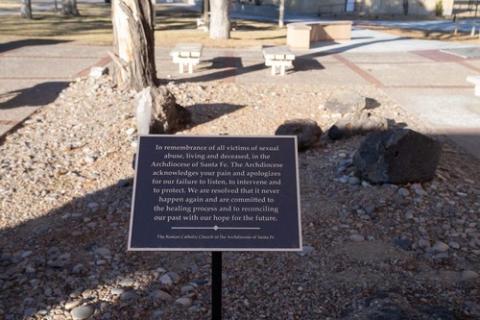
A plaque outside the Archdiocese of Santa Fe offices in Albuquerque. (Nadav Soroker/Searchlight New Mexico)
"The story of the Archdiocese of Santa Fe is you have many, many, many priests who came from elsewhere to 'civilize,'" said Kathleen Holscher, endowed chair of Roman Catholic Studies at the University of New Mexico. "That's a dynamic here. If you look at the credibly accused list for the Archdiocese of Santa Fe, most of the priests are Anglo … there was a sort of 'civilizing' impulse that was guiding how they understood the kind of clergy that should be working with these people, certainly through the 19th century."
It's difficult to have these conversations in a place like New Mexico without acknowledging the backdrop of settler colonialism — the Archdiocese of Gallup, for example, was founded in 1939 as the nation's only "Indian Diocese." But much of the abuse documented in the 20th and 21st centuries was of a different stripe.
"You don't have the same explicit discourse of 'civilizing,'" Holscher said. "But what you have is an archdiocese that doesn't have infrastructure. I think that's left over from the 19th-century legacy. You have an archdiocese that's reliant on priests coming in from other places." It's challenging to train priests in New Mexico and keep them here, she said, pointing to the lack of a local seminary and high levels of poverty.
There's a subset of prominent abusers who do not fit this mold. Holscher points to Sabine Griego, a priest who was accused of raping a child in the 1990s at the Queen of Heaven grade school in Albuquerque, and who died weeks before he was set to stand trial in 2020. Priests like him were able to get close to their victims by "filling a vacuum," Holscher said. They weren't white, and they weren't concerned with "civilizing" their parishioners who had darker skin.
"Those guys were given so much freedom in their community, in part because there was such a vacuum of priests of Hispanic descent," she said.
Until his death, Griego maintained his innocence. His name appears on the Archdiocese of Santa Fe's credibly accused list.
'In remembrance of all victims'
On a late September day in 2024, a small crowd gathered outside St. Pius X High School in Albuquerque, a Catholic private school campus that also serves as headquarters for the Archdiocese of Santa Fe.
The crowd was there to watch the archdiocese carry out one of the "non-monetary" terms of the settlement plan: Installing a plaque dedicated to the survivors of sexual abuse.
"In remembrance of all victims of sexual abuse, living and deceased, in the Archdiocese of Santa Fe," the plaque says. "The archdiocese acknowledges your pain and apologizes for our failure to listen, to intervene, and to protect. We are resolved that it never happen again and are committed to the healing process and to reconciling our past with our hope for the future."
It had been just more than seven years since the archdiocese first published its credibly accused list, which at the time included 74 priests. Seven years, one bankruptcy and $121.5 million in settlements later, the list has only grown by nine.
